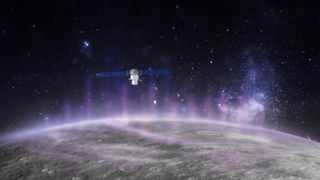Home
News
Science & Astronomy

Artist’s representation of the ESA/JAXA BepiColombo mission flying through precipitating electrons that can trigger X-ray auroras on the surface of Mercury.
(Image credit: Thibaut Roger/Europlanet (CC BY-SA 4.0))
The way in which the radiant displays of colors in the sky known as auroras form on Earth may be how these lights arise throughout the solar system, according to new findings from Mercury.
On Earth, auroras — also known as the northern and southern lights — result when streams of high-speed particles from the sun, collectively known as the solar wind, slam into our world’s magnetosphere, the shell of electrically charged particles trapped by the planet’s magnetic field.
Mercury, the smallest and least massive of the solar system’s planets, also possesses a magnetosphere. However, its magnetosphere is typically only about 5% the size of Earth’s. This is because the magnetic field of Mercury is less than 1% as strong as our planet’s, Sae Aizawa, a planetary scientist and space plasma physicist at the Institute for Astrophysics and Planetology Research in Toulouse, France, told Space.com.
Related: Aurora colors: What causes them and why do they vary?

Observations by Mio/BepiColombo during its first Mercury flyby of electrons precipitating towards Mercury’s surface, in correlation with the anticipated locations of X-ray aurorae reported by NASA’s mission. (Image credit: Sae AIZAWA)
The magnetosphere of a planet often acts as a barrier to solar wind flow, in the same way as a boulder in a stream serves as an obstacle to flowing water. However, previous research found that, depending on how Earth and Mercury are oriented with respect to the interplanetary magnetic field from the sun, the magnetospheres of both those planets regularly become open to the solar wind.
On Earth, the entry of the solar wind into the magnetosphere drives the motions of electrons and other electrically charged particles. At the poles, these electric currents flow into the planet’s atmosphere, race down Earth’s magnetic field lines and crash into molecules in the upper atmosphere, generating auroral light.
Previous research detected very high-energy electrons and X-rays from Mercury. However, those studies lacked the tools to monitor the relatively low-energy electrons that usually power auroras.
Now Aizawa and her colleagues have discovered evidence that auroras on Mercury have the same origins as they do on Earth. The results suggest that “these processes are a universal mechanism for aurora generation,” Aizawa said.
In the new study, the scientists analyzed data from the BepiColombo mission, a joint effort from the European Space Agency and the Japan Aerospace Exploration Agency to study Mercury. Launched in 2018, BepiColombo made its first of six flybys of Mercury in 2021 and is planned to orbit Mercury starting in 2025, making it the first mission to another planet to consist of two satellites.
BepiColombo found that relatively low-energy electrons in Mercury’s magnetosphere can accelerate in the planet’s dawn areas and then get pumped into magnetic field lines on the world’s nightside. Since Mercury has an incredibly tenuous atmosphere compared to Earth’s, these electrons do not strike the air, but instead slam onto Mercury’s surface, generating X-ray auroras.
All in all, although the planets of the solar system differ in many respects from each other, such as the strength of their magnetic fields and the composition of their atmospheres, the way in which electrons can get accelerated at planets to generate auroras appears universal across these worlds, Aizawa said.
The scientists detailed their findings online today (July 18) in the journal Nature Communications.
Join our Space Forums to keep talking space on the latest missions, night sky and more! And if you have a news tip, correction or comment, let us know at: [email protected].
Breaking space news, the latest updates on rocket launches, skywatching events and more!
Charles Q. Choi is a contributing writer for Space.com and Live Science. He covers all things human origins and astronomy as well as physics, animals and general science topics. Charles has a Master of Arts degree from the University of Missouri-Columbia, School of Journalism and a Bachelor of Arts degree from the University of South Florida. Charles has visited every continent on Earth, drinking rancid yak butter tea in Lhasa, snorkeling with sea lions in the Galapagos and even climbing an iceberg in Antarctica. Visit him at http://www.sciwriter.us
>>> Read full article>>>
Copyright for syndicated content belongs to the linked Source : Space.com – https://www.space.com/auroras-similar-cause-throughout-solar-system-mercury-results






























